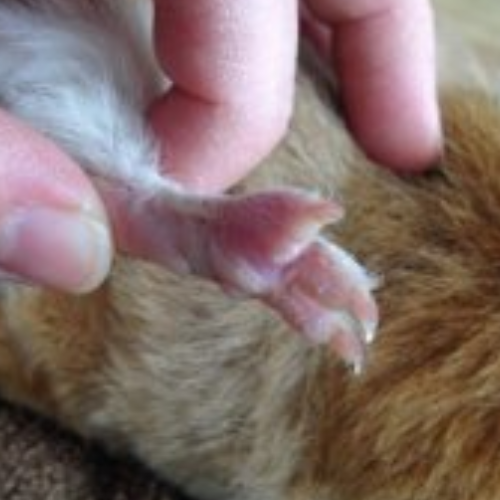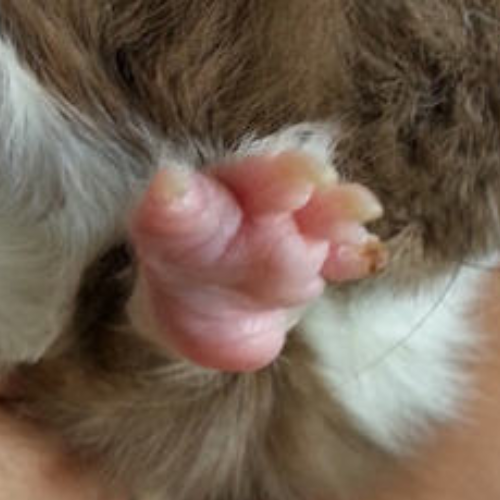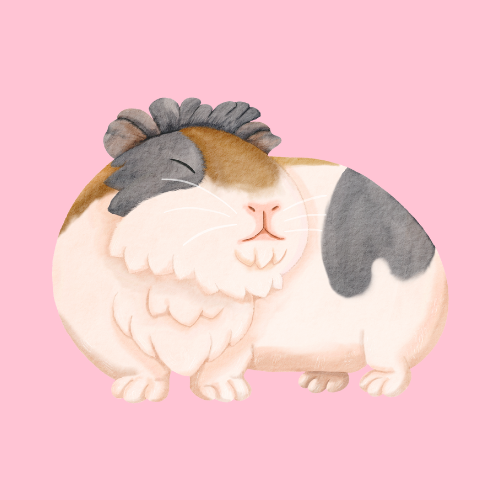The Four Stages of Bumblefoot in Guinea Pigs
1st Stage: Irritation of the Feet
When bumblefoot is in its early stages, it might not be easy to distinguish it. On the other hand, regular grooming is a wonderful method to keep an eye out for indications of it.
The following are the first signs and symptoms:

- Hair loss on the heels of the feet
- Inflammatory calluses on the heel that look red and unpleasant
- Your guinea pig may become less active as a result of the discomfort and pain
2nd Stage: Inflammation
This stage is much easier to identify. The following are the signs that bumblefoot is progressing:

- Skin peeling or scabbing in the vicinity of the affected region
- Your guinea pig’s activity level will substantially decrease
3rd Stage: Infection
When an infection has taken hold, you are at Stage 3. Symptoms will be easy to identify and may include the following:

- Bleeding
- Scrubbing the area surrounding the affected region
- Your guinea pig will be unable to move and will weep or make harsh, high-pitched noises.
- Large sores or blisters can be observed to have formed on the feet.
- Your guinea pig may get dehydrated and stop eating and drinking.
- Expulsion of fluid from the wound
4th Stage: Infection of the Bones and Soft Tissues
This is the last and most deadly stage, in which the infection has spread throughout the body’s tissues and bones.
The following are symptoms of Stage 4:
- Paralysis
- Expulsion of severe foul-smelling fluid from the affected region
- Extreme pain that may induce your guinea pig to chew its teeth
If you see any of these life-threatening signs, you should take your guinea pig to your veterinarian for a thorough examination.
How To Treat Bumblefoot in Guinea Pigs? Treating mild occurrences of bumblefoot can be successful; your veterinarian may prescribe pain relievers and a skin lotion to be regularly applied to the affected region.
The underlying reasons for the problem, such as unsuitable substrates or obesity, must be addressed in order for the problem to be completely remedied. Your veterinarian may need to heal the wounds on the foot, administer pain medication, and prescribe an extended course of antibiotics in more severe instances. In some circumstances, it may take many weeks to several months of intense therapy and antibiotics before the bumblefoot is completely healed. Removing the affected limb may be necessary in extreme cases if the infection has grown so serious that it has either reached the bloodstream or developed osteomyelitis (bone infection at Stage 4).
What to Do if You Think Your Guinea Pig Has Bumblefoot?
If you see any of these life-threatening signs, you should take your guinea pig to your veterinarian for a thorough examination.
Treating mild occurrences of bumblefoot can be successful; your veterinarian may prescribe pain relievers and a skin lotion to be regularly applied to the affected region. The underlying reasons for the problem, such as unsuitable substrates or obesity, must be addressed in order for the problem to be completely remedied. Your veterinarian may need to heal the wounds on the foot, administer pain medication, and prescribe an extended course of antibiotics in more severe instances. In some circumstances, it may take many weeks to several months of intense therapy and antibiotics before the bumblefoot is completely healed. Removing the affected limb may be necessary in extreme cases if the infection has grown so serious that it has either reached the bloodstream or developed osteomyelitis (bone infection at Stage 4).
Guinea Pig Pododermatitis
Bumblefoot, also known as pododermatitis, is a somewhat common illness that affects the feet, particularly the heel, of guinea pigs. While it is undoubtedly unpleasant, if left untreated, it can result in serious sickness or, in the worst-case situation, death.
To be a responsible piggy parent, you should be aware of the causes, symptoms, and best ways to treat your guinea pig’s health concerns.
Poor husbandry measures mostly cause Pododermatitis. Guinea pigs kept on abrasive surfaces, such as wire-floored cages, unclean and moist bedding, and abrasive carpets, are more susceptible to contracting the disease. The term pododermatitis refers to an inflammation of the skin of the Guinea Pig’s foot.
Understanding Guinea Pig Pododermatitis
Here are some pointers that give us a better understanding of How pododermatitis/bumblefoot occurs in Guinea Pigs.
- Inappropriate bedding: Guinea pigs can suffer from various health problems, including bumblefoot as a result of soiled and unclean bedding. This illness is quite dangerous and has the potential to be fatal. One method of avoiding bumblefoot is always to use guinea pig-friendly bedding material when constructing their hutch or enclosure.
- Hard surfaces: Guinea Pigs, in contrast to other animals, do not have pads on their feet, which means their paws are extremely sensitive. Consider occasions when you have had to walk in rough or painful places without shoes to understand better what we are talking about. The same holds true for guinea pigs. Bumblefoot can occur when a Guinea Pig is compelled to walk on wire, tiles, or carpets for long periods of time.
- Obesity: The development of bumblefoot in guinea pigs who are overweight or obese is more prevalent. This is due to the fact that any action puts tension on their footpads, resulting in this severe disease. An overweight Guinea Pig kept in a cage with steel/metal wires on the floor is more likely to develop bumblefoot than a healthy Guinea Pig.
- Loss of fur: Guinea pigs have hair/fur on the bottoms of their feet to protect them from predators. However, when their fur is no longer there, they become more vulnerable to injury. Fur/Hair loss can be caused by a variety of factors, including the following:
- Rough surfaces: Rough surfaces can scratch and create wounds on our guinea pigs’ feed which may lead to bumblefoot.
- Overgrown nails: Guinea Pigs are quite adept at keeping themselves neat, but some grooming tasks require assistance, particularly with the trimming of their nails. If the guinea pig’s nails are not kept clipped, they can grow into the padding of their feet, leading to bumblefoot. Keeping your Guinea Pig’s feet clean also provides you the opportunity to catch any bacterial illnesses early on before they become problematic.

Doctor of Veterinary Medicine (D.V.M.) at Nation Taiwan University,Master of Science (M.S.) in Biomedical Engineering at National Taiwan University of Science and Technology




